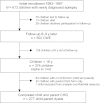Psychiatric and medical comorbidity and quality of life outcomes in childhood-onset epilepsy
- PMID: 22123895
- PMCID: PMC3387901
- DOI: 10.1542/peds.2011-0245
Psychiatric and medical comorbidity and quality of life outcomes in childhood-onset epilepsy
Abstract
Objective: We compared associations of epilepsy remission status and severity as well as psychiatric and other comorbidities with child and parent-proxy reports of health-related quality of life (HRQoL) in adolescents previously diagnosed with epilepsy.
Methods: In a prospective, community-based study of newly diagnosed childhood epilepsy, HRQoL of 277 children was assessed 8 to 9 years after diagnosis by using child and parent-proxy versions of the Child Health Questionnaire (CHQ). Multiple linear regression models adjusted for age and gender were used to compare associations of epilepsy remission and "complicated" epilepsy (secondary to an underlying neurologic insult or epileptic encephalopathy) status and psychiatric and other comorbidities with HRQoL.
Results: Mean age of epilepsy onset was 4.4 years (SD: 2.6). At the 9-year reassessment, children were, on average, 13.0 years old (SD: 2.6); 64% were seizure-free for 5 years, 31% were taking antiepileptic drugs, and 19% had a complicated epilepsy. Prevalence of comorbidities at follow-up were 26% psychiatric diagnosis; 39% neurodevelopmental spectrum disorder (NDSD); 24% chronic medical illness; and 15% migraine. In multivariable analysis, having a psychiatric disorder was broadly associated with child (6 of 11 scales) and parent-proxy (7 of 12 scales) HRQoL (P ≤ .0125). Five-year remission and complicated epilepsy status had few or no associations with HRQoL. Although parent-proxy HRQoL was strongly associated with NDSD (6 of 11 scales), child-reported HRQoL was not (2 of 11 scales).
Conclusions: Psychiatric comorbidities are strongly associated with long-term HRQoL in childhood-onset epilepsy, which suggests that comprehensive epilepsy care must include screening and treatment for these conditions, even if seizures remit.
Figures



Comment in
-
Epilepsy: Determinants of quality of life in epilepsy go beyond seizure-related variables.Nat Rev Neurol. 2012 Jan 17;8(2):59. doi: 10.1038/nrneurol.2011.214. Nat Rev Neurol. 2012. PMID: 22249841 No abstract available.
References
-
- Linehan C, Berg A. Epidemiologic aspects of epilepsy. In: Wyllie E, Cascino GD, Gidal BE, Goodkin HP. eds. Wyllie's Treatment of Epilepsy: Principles and Practice. Philadelphia, PA: Lippincott, Williams & Wilkins; 2011:2–10
-
- Alfstad KA, Clench-Aas J, Van Roy B, Mowinckel P, Gjerstad L, Lossius MI. Psychiatric symptoms in Norwegian children with epilepsy aged 8–13 years: effects of age and gender? Epilepsia. 2011;52(7):1231–1238 - PubMed
-
- Caplan R, Siddarth P, Gurbani S, Hanson R, Sankar R, Shields WD. Depression and anxiety disorders in pediatric epilepsy. Epilepsia. 2005;46(5):720–730 - PubMed
-
- Clarke DF, Roberts W, Daraksan M, et al. The prevalence of autistic spectrum disorder in children surveyed in a tertiary care epilepsy clinic. Epilepsia. 2005;46(12):1970–1977 - PubMed

